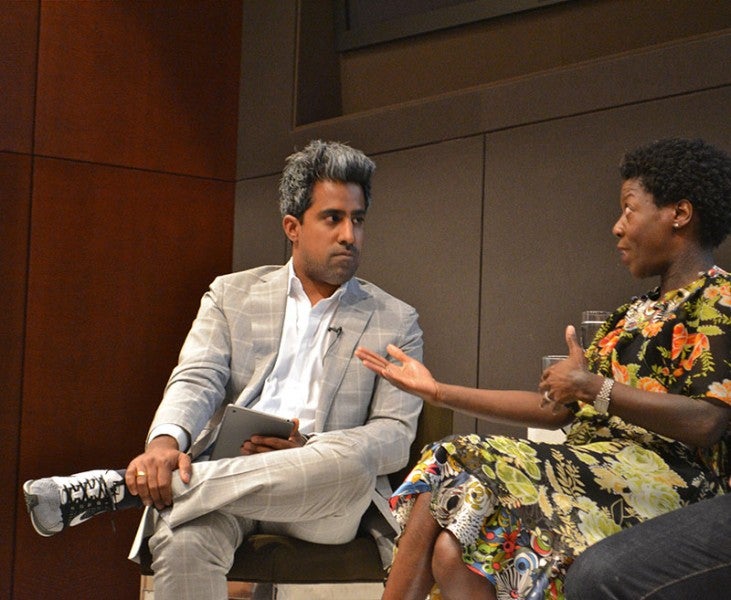
Anand Giridharadas, New York Times columnist and panel moderator, with Thelma Golden, director and chief curator of The Studio Museum in Harlem, at an Aspen Across America event in New York, NY. (Photo Credit: Patricia King)
The Aspen Institute Aspen Across America program recently hosted a panel, Making, Collecting, and Experiencing Art in the Digital Age in partnership with Christie’s New York.
The changing landscape of the digital age poses a unique set of challenges and opportunities for artists, collectors, and curators. With the proliferation of digital tools and social media, art is now more accessible, but at what cost? What is the value in something that is infinitely reproducible? When does the promotion of art via social media become art itself? What happens to a digital work of art once its platform is rendered outdated by technological advances? And is there an actual, existential meaning to the “selfie?”
The June event featured opening remarks from Christie’s President Doug Woodham and Aspen Institute Executive Vice President Elliot Gerson. The panel included Anand Giridharadas, New York Times columnist and panel moderator; Thelma Golden, director and chief curator of The Studio Museum in Harlem; Matthew Ritchie, artist; and Kevin Slavin, assistant professor and founder of Playful Systems group at the Massachusetts Institute of Technology. Both Giridharadas and Golden are members of the Aspen Institute Henry Crown Fellowship Program.
On infinite reproducibility and the value of art:
Anand Giridharadas: How does an artist protect the integrity of their work when it is so easy to copy and paste? So much of the value of art is that there is only one Mona Lisa that can only be in one room at the same time.
Kevin Slavin: In many ways it’s not a new problem. It’s a problem that takes on certain exaggerated proportions. There’s a curve to it. But the problem of reproducibility is at least a hundred years old and has been explored, and in some ways, resolved. But I think the thing that’s interesting are the artists who are leaning into that head on. If you look at the artists who looked at the question of reproducibility as an operational opportunity, which is — let’s say from the mid-1960s on — people who were taking industrial modes of reproduction and saying, ‘this is how we make stuff now.’ The question is, ‘What artists will take on the digital mode of reproduction?’ and actually lean into it all the way and say ‘the fact [that] this can be infinitely reproducible is its meaning.”
Personal branding in art:
AG: In so many fields, the idea of the personal brand is saturating art — infesting, depending on your view — and creative people have to do so much now to promote themselves. How are you seeing that [the need to communicate a brand through Facebook and Twitter], if at all, enter the world of artists that you know. Is it a gain in their work or a drag?
Thelma Golden: I think there are a variety of experiences, and for some artists, the ability to have a relationship with various audiences without an institution, whether it’s a museum or gallery, in the middle of it is extremely liberating and actually becomes a process in the work. For other artists, it’s not important at all. It’s not the way in which they want their work experienced. I think what’s important for an audience member, even a professional like myself, is that again, this gives us more opportunity.
On the other hand, there are many artists for whom these tools [Instagram and Facebook] become the experience completely, of not only how they put themselves out there, but how the work narrative plays out… I think that things like social media have challenged the idea of what we consider the artist’s archive. Because truth be told, as museums, for example, we have always collected archival material. And yes, in some ways social media is archivally important. How we collect that is one of the ways in which we are beginning to reinvent ourselves as institutions.
Impact of funding on the herd mentality:
Matthew Ritchie: There is a danger in ever-increasing transparency and accessibility influencing artists to the extent that, if you see that there’s a crowd phenomenon or an algorithm, it does start to produce so many of them. And there is a real issue — but this is true with all fields, with sciences and politics —people will start to see the same goal they should aspire to because there’s funding.
The significance and meaning of the ‘selfie:’
TG: I think it’s a manifestation of both a reaction to the idea of self-portraiture, but really more importantly about self-identification, which is something we all have a desire to do. But I do feel that something about selfie culture is really about something primal, about the need to mark and identify one’s self as an individual.
MR: Well I think it’s related to the unacknowledged problem with digital art and time. All of us are leaving this trail of images, which are sometimes as casual as a snapshot, but other times they’re files of emails you really wished didn’t exist in the world, or a text. It’s all being kept, and in the end, that will constitute the record of your life. And your great-grandchildren will be able to look you up… they’re going to look at the selfies and they’re going to see this trail moving through time and watching you dissolve and reconstituting yourself. I think the selfie is just a little glimpse of what’s coming.
Mary Grace Pellegrini is with Aspen Across America.

